All cats are gray in the dark
An astronomical view on the physiology of vision

| rhodopsin activation | dark adaptation | rods vs. cones |
|
All cats are gray in the dark An astronomical view on the physiology of vision |
 |
part 3
Rods vs. cones: Why do we need our rod cells at night?
| That's obvious!
Because the cones are much less sensitive than the rods! But why is it? Good question! The photoreceptors in rods and the three cone types are different, as we saw in part 1. The have different spectral sensitivities and allow for trichromatic vision, i.e. our color vision. As we saw in the preceding parts, rhodopsin is the actual photoreceptor in the rod cells. For the cone "rhodopsins", several designations are being used, such as iodopsins or photopsins. In the scientific literature they are usually termed simply as cone pigments. In the following, we will therefore look at rhodopsin in the rods and cone pigments in the cones. Once again, rhodopsin and the three types of cone pigments have very different spectral sensitivities, as evident also in the figure. But: Despite this differing spectral sensitivities, the overall sensitivity, i.e. the quantum yields of rhodopsin and cone pigments are almost identical at about 67%. Therefore it cannot be due to the pigments that cones are much less sensitive than rods. At least that's what one might think. But it is wrong. |
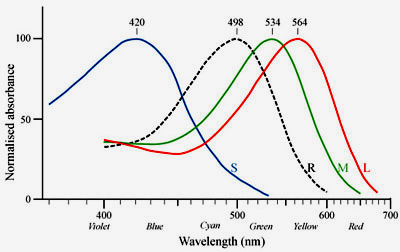
|
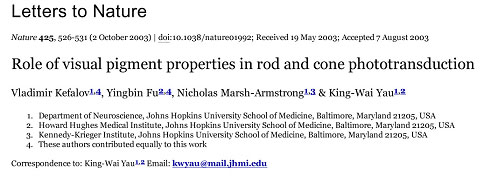 Kefalov et al. (2003) Nature 425:526
|
Cones and rods The lower sensitivity of the cones as compared with the rods is partly due to the pigments, even though the pigments themselves have similar sensitivities. It is more complicated and Vladimir Kefalov and King-Wai Yau at Johns Hopkins University in Baltimore, USA, have contributed substantially to understand the underlying mechanisms more thoroughly. |
| The developed a very
sophisticated test system and created in their molecular biology labs cone
cells that contained rod rhodopsin and vice-versa rod cells that contained
red (L) cone pigment. Using this test system, they could compare rhodopsin
and L cone pigment in the same cellular environment. The picture to the
right shows in the first two panels rod cells without cone pigment
(controls) and in the last two panels rod cells that expressed small
quantities of L cone pigment (human red and salamander red) bearing a
fluorescence marker.
Kefalov and his colleagues revealed that the cone pigments are as sensitive as rod rhodopsin. Also the signal gain in the cones is not very different from that in rods, in contrast to previous thinking. The cone pigment did, however,
increase the dark noise of the cell as compared with rod rhodopsin (see the
bottom of the last two columns). Keep in mind, that the contribution of the
cone pigments in the last two columns was less than 0.1 percent! |
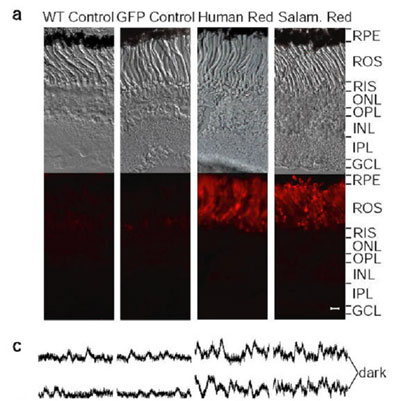 |
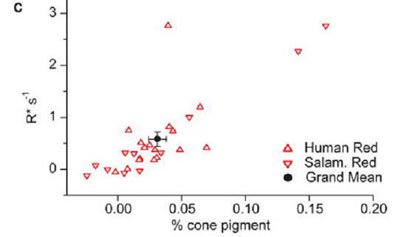 |
Cone pigment-dependent dark noise These results are shown here in more detail. The amount of cone pigment in the rods was always very low and in the sub percent range. But even such a tiny fraction of cone pigment was enough to increase the dark noise of the rod cell significantly and this rise was a linear function of the percentage of cone pigment. This dark noise reflects spontaneous retinal isomerizations in the cone pigments, which is increases as compared with rod rhodopsin by a factor of about 20 000-fold. This "thermal" noise makes the cell "see" virtual light, even in complete darkness. Well, we've heard of a similar thing before, didn't we ...
|
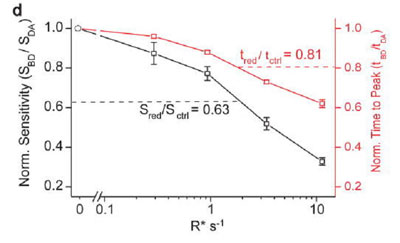 |
The higher the dark noise, the more of this "virtual light" is "seen" by the photoreceptor cell, and the less sensitive the cell becomes: The cell stays light adapted, with the signal amplification down regulated. The cell can no longer undergo dark adaptation. This is shown in this figure: The sensitivity of the cell is plotted vs. differing amounts of cone pigment and hence differing thermal activation rates (activated photoreceptor proteins per second, R*/s).
|
| Thermal activation
of cone pigment The situation is quite similar as with opsin in the preceding part. But this time not opsin is the evildoer, but the spontaneous thermal isomerization of retinal in the cone pigments, that makes the cell "see" virtual light. For comparison:
There are several ideas how this increased spontaneous activation of cone pigments can be explained. A very interesting idea was put forward by Victor Lorenz, who proposed that protein fluctuations are necessary for the retinal chromophore to isomerize with low energy barrier: Lorenz-Fonfria et al. (2010) J Am Chem Soc 132:5693. Newer studies suggest that the above mentioned number is to high and the increase in noise is rather a factor of 1000x. Furthermore, they suggest that there are further differences between rods and cones in the downstream elements of the signaling cascade that are as well responsible for the increased noise in cone cells.
|
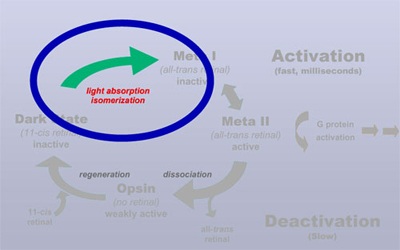 |
|
Summary: Rods and cones
This reduction in sensitivity by about 5 mag can be easily verified in practice. Under good rural skies, the dark adapted eye can see stars down to about mag 6. They are detected with the rod cells (and peripheral vision, another topic) and appear gray, no color. In order to see star colors, we need our cones. With the 5 mag difference in sensitivity, we should be able to see star colors for stars of mag 1 and and brighter, which is confirmed in practice.
|
| Can we see Hα
at night? In order to see Hα at 656 nm, wee need our L cones. They are the most red sensitive cone type, but even for them 656 nm is at the very edge in the right wing where sensitivity is already substantially lower than at peak. The precluded dark adaptation and hence the further reduction of sensitivity by 5 mag further don't make things better. This implies: We can in theory see Hα at night using our L cones, if (!) the objects are bright enough. I did test this using a 20-Inch Dob and a 630nm long pass filter to block all emission lines except for Hα (and the closely neighbored NII lines at 655 and 658nm). With this setup, I tested for visibility a number of emission nebula during a winter night. Only with one object (see image to the right), I was sure to see "something". With all other emission nebula, the intensity was too low for the given spectral sensitivity of our eye. |
 |
|
This is definitely different for the OIII
line. The OIII line emits at 496 and 501 nm, where S, M, and L cones have an
in part considerably higher sensitivity (see figure). This is confirmed in
practice as there are a number of small and bright planetary nebula, that
have high OIII intensity and that appear in particular with large telescopes
distinctly greenish to turquoise.
Once again: Red light at the telescope On the preceding page, we were talking about red light at the telescope. We concluded that with deeply red light we would minimize the impact on rod dark adaptation at the expense of light adaptation of the L cones (which doesn't bother us). This made sense at that point and was supported by the relative spectral sensitivities of the different photoreceptors. As the cones do not undergo full dark adaptation, they are intrinsically less sensitive than the rods. The graph to the upper right with the relative spectral sensitivities is therefore a bit misleading. Rather, we should compare overall absolute spectral sensitivities of rods and cones. These absolute sensitivities depend on many factors and it is difficult to make a really objective comparison. The graph to the lower right gives a clue, how absolute sensitivities might relate between rods and cones (mind the logarithmic scale!). The graph reveals in the green range, as expected, the higher sensitivity of the rods. In the very red range above 630nm, the sensitivity of the cones is, however, not substantially higher than that of the rods, which is due to the intrinsically higher sensitivity of the rods. This puts our red light story in a different perspective. It is not sufficient to use a red flash light with wavelengths >630 nm and we're fine. When the red light is bright enough to activate our L cones, it will simultaneously activate our rods as well (and that's what we wanted to avoid in any way!). The conclusion is therefore: our red flash light should not only have light >630nm, it should as well be as dim as possible! How can I find out, whether my flash light emits only light >630nm? The most direct way is to use a small spectroscope, as the one sold by astromedia.de. If you build the flash light yourself, you can get the respective information also from the manufacturer or distributor of the LEDs. In any case, if your flash light shows even the slightest hint of orange light, it definitely emits light below 630 nm.
|
|
| Good web pages on
vision and dark adaptation:
Some scientific papers on adaptation: Kevalov et al. (2003) Nature 425:526 Leibrock, Reuter, Lamb (1998) Eye 12:511
A list of my own work on rhodopsin is here and here.
|
![]()
| rhodopsin activation | dark adaptation | rods vs. cones |